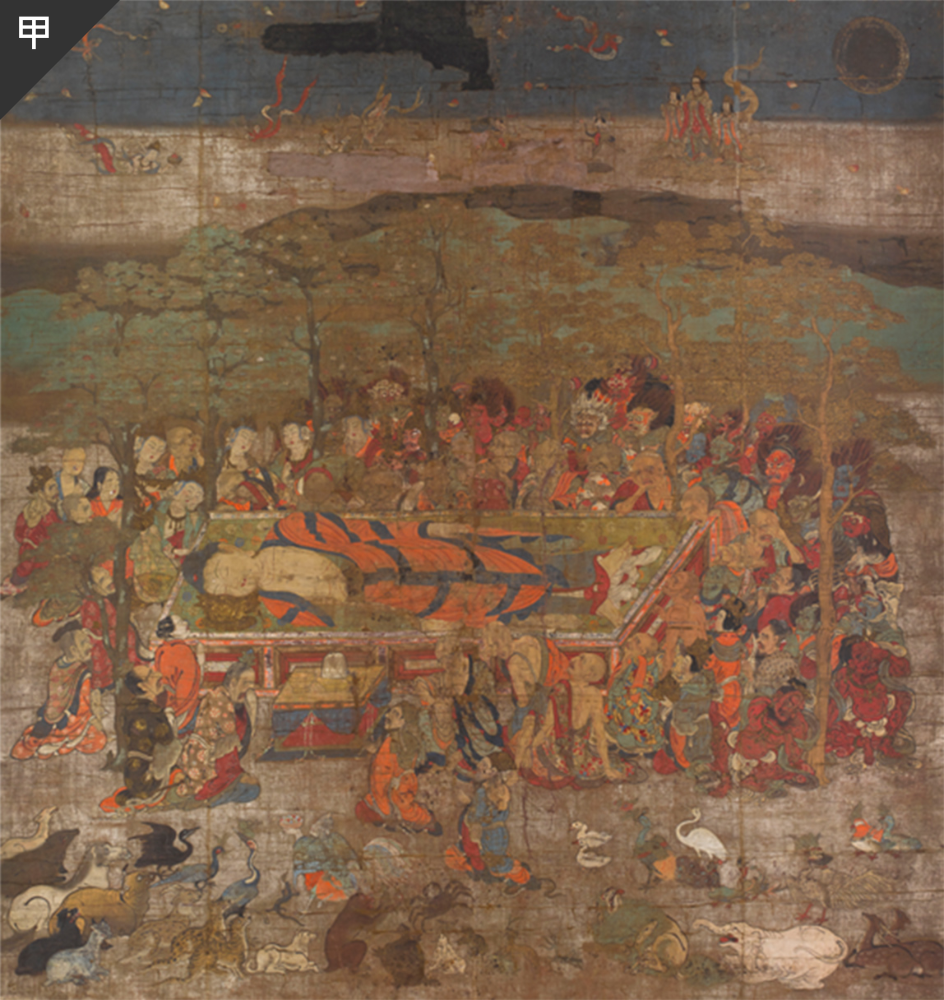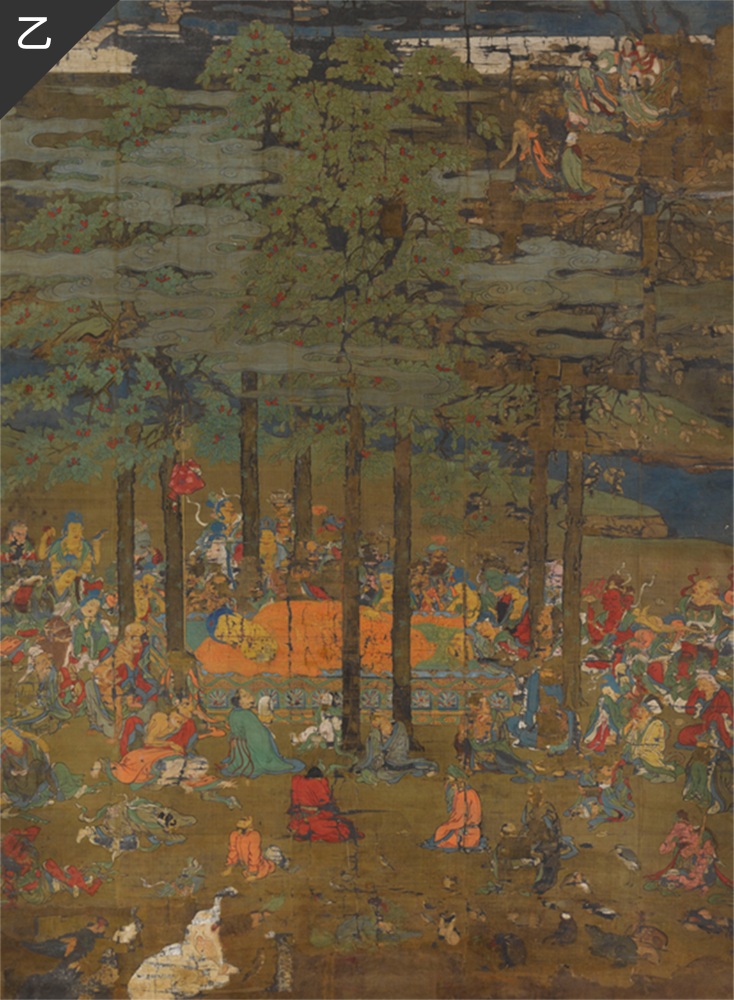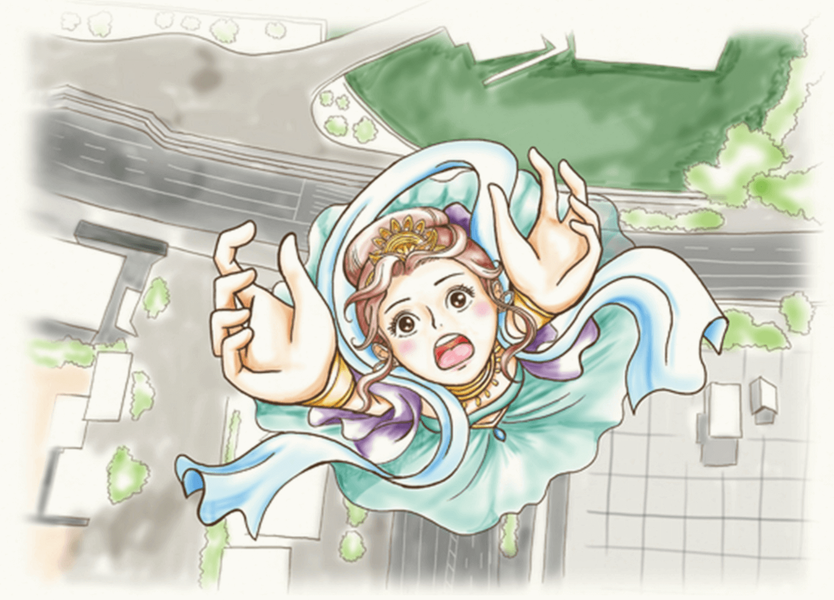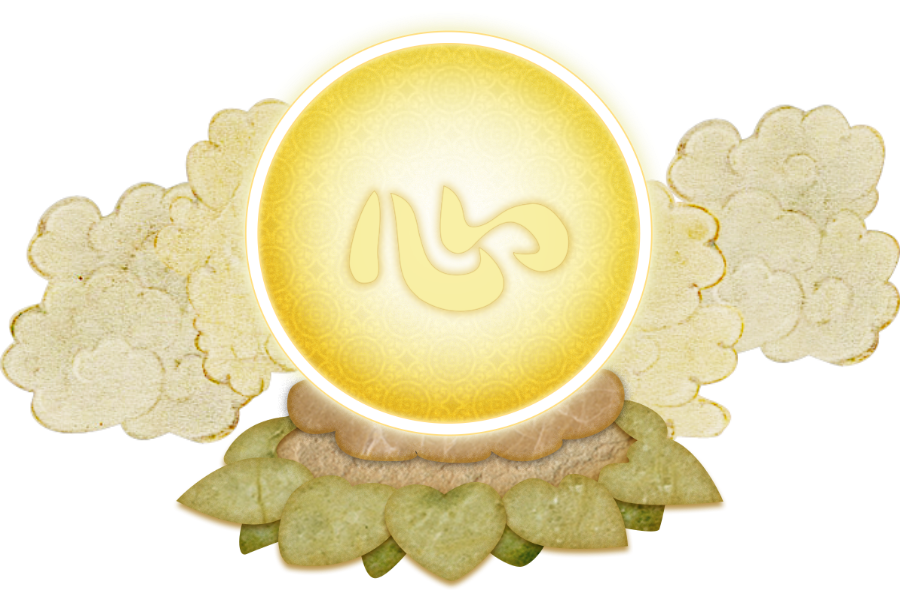ここから本文です。

- TOP
- Digital Museum
- Maya's Journey Home
- MAYA’S WORLD
- Painting of the Buddha Attaining Nirvana




Painting of the Buddha Attaining Nirvana
The historical Buddha (Siddhartha Gautama) is said to have died on the night of February 15 by the ancient Indian calendar near the Hiranyavati River in Kushinagar, between a pair of sala trees, reclining on his side with his head pointing north and his right side down. This death is referred to as nehan, or Nirvana. This scene and the events preceding and following it are described in sutras known collectively as Mahaparinirvana sutras. The sutras of the Mahayana tradition contain a large number of miracles, and the Buddha’s passing into Nirvana is interpreted as his having returned to the eternal, unchanging True Self beyond the cycle of death and rebirth.
Paintings depicting the scene are known as butsu nehan zu, or “Paintings of the Buddha Attaining Nirvana.” At temples in Japan, every year on February 15 by the old lunar calendar there have traditionally been gatherings to commemorate the Buddha’s passing, and these paintings hung as the principal image of worship.
Explanation of all figures
[ I ] Painting of the Buddha Attaining Nirvana
One of these paintings shows the bed from an angle where the foot can be seen, and is depicted from a low perspective looking up at the Buddha’s feet and front of body (the south and west directions). Lying with his right side down, the Buddha stretches out both arms alongside his body and rests his right cheek on a lotus pedestal. This basic composition is typical of older depictions of this subject.
![[ I ] Painting of the Buddha Attaining Nirvana](/wp-content/themes/rekihaku/assets/img/digital_museum/maya/ex/ex0010/main03.png)
This painting has some features that are unusual for the genre. Heavenly musical instruments float in space, and two angelic beings scatter flowers, with flowers and petals floating here and there. Also Maya, the mother of Siddhartha Gautama, has appeared on her own along with two lady-in-waitings, and a rice bowl and a devotional bowl are lined up on an offering stand. In these portrayals, we may infer the influence of the fourth section of the Dirgha Agama Sutra of Hinayama Buddhism, in which Devas descend from the heavens to scatter flowers on the Buddha, and Maya recites a poem by his deathbed.
![[ I ] Painting of the Buddha Attaining Nirvana](/wp-content/themes/rekihaku/assets/img/digital_museum/maya/ex/ex0010/main04.png)
![[ I ] Painting of the Buddha Attaining Nirvana](/wp-content/themes/rekihaku/assets/img/digital_museum/maya/ex/ex0010/main05.png)
However, the painting most closely resembles the apocryphal Mahamaya Sutra, which describes Maya descending from the heaven of the Devas with angels playing sacred music, burning incense, scattering flowers, reciting poetry, and praising Gautama Buddha, and collects the belongings he has left behind: a priest’s robe, a devotional bowl, and a staff.
![[ I ] Painting of the Buddha Attaining Nirvana](/wp-content/themes/rekihaku/assets/img/digital_museum/maya/ex/ex0010/main06.png)
![[ I ] Painting of the Buddha Attaining Nirvana](/wp-content/themes/rekihaku/assets/img/digital_museum/maya/ex/ex0010/main07.png)
![[ I ] Painting of the Buddha Attaining Nirvana](/wp-content/themes/rekihaku/assets/img/digital_museum/maya/ex/ex0010/main08.png)
Another apocryphal sutra, the Sutra on the Buddha’s Mother, does not refer to angels burning incense or scattering flowers, but describes the Buddha’s robe being atop his coffin, and a devotional bowl and a staff hanging from the trees. In this painting Gautama is still wearing his robe, and one of the devotional bowls is still on the offering stand, and the staff with the other bowl attached is leaning against the sala tree, which is similar to the description in the Sutra on the Buddha’s Mother. A similar depiction of this scene in a painting can be seen in the earlier work of the same title belonging to the Tokyo National Museum. “Butsu-nehan-zu” (Tokyo National Museum) that produced in late Heian period describes Queen Maya and a her son’s staff on his bedside. It depicts also a bowl and a cloth on the offerings table along with celestial beings scattering petals in the sky.It describes also a bowl and a cloth on the offerings table along with celestual beings scuttering pedals in the sky. Those peculiarity is very similar to our painting.
![[ I ] Painting of the Buddha Attaining Nirvana](/wp-content/themes/rekihaku/assets/img/digital_museum/maya/ex/ex0010/main09.png)
![[ I ] Painting of the Buddha Attaining Nirvana](/wp-content/themes/rekihaku/assets/img/digital_museum/maya/ex/ex0010/main10.png)
Later in these two apocryphal sutras, when Maya is holding her son’s belongings and mourning his death, the Buddha comes back to life, arises from his coffin and begins to preach, a vivid illustration of his eternal nature. Therefore, if this painting would be analyzed through Queen Maya, this painting skilfully positions the figures and objects around the Buddha so as to set the stage for his revival and preaching, giving visual expression to the eternal nature of the Buddha in a manner that could be called characteristic of Mahayana Buddhism.
[ II ] Painting of the Buddha Attaining Nirvana
The other of the two paintings shows the bed from an angle where the head can be seen, looking down from a high perspective toward the Buddha’s pillow. He is rendered in a golden tone and rests his head on one arm, in a depiction following the Hinayama Buddhist epic poem Buddhacharita. This basic composition is typical of newer examples of the genre. The painting contains a large number of other motifs common in late medieval Japanese portrayals of this scene.
![[ II ] Painting of the Buddha Attaining Nirvana](/wp-content/themes/rekihaku/assets/img/digital_museum/maya/ex/ex0010/main11.png)
For example, the sala trees surrounding the bed are in four pairs, two for each direction of the compass, and are dry and bleached, resembling white cranes. Anuruddha, one of Gautama’s disciples, splashes water on Ananda, another disciple, who has fallen unconscious in agonizing grief. And an old woman prostrates herself in prayer holding the Buddha’s feet. These elements have their basis in the 40th fascicle of the Mahāyāna Mahāparinirvāṇa Sūtra and in its sequel.
![[ II ] Painting of the Buddha Attaining Nirvana](/wp-content/themes/rekihaku/assets/img/digital_museum/maya/ex/ex0010/main12.png)
![[ II ] Painting of the Buddha Attaining Nirvana](/wp-content/themes/rekihaku/assets/img/digital_museum/maya/ex/ex0010/main13.png)
![[ II ] Painting of the Buddha Attaining Nirvana](/wp-content/themes/rekihaku/assets/img/digital_museum/maya/ex/ex0010/main14.png)
The depiction of a disciple of the Buddha, thought to be Anuruddha or Upali, guiding Maya, and the devotional bowl and staff hanging in the trees, are derived from the apocryphal Mahamaya Sutra and Sutra on the Buddha’s Mother. The standardization of compositions and motifs in paintings of the Buddha on his deathbed may have been influenced by the popularization of the Nirvana Sutra, which drew material from the biographies of Siddhartha Gautama, Shaka-fu and Shizako-shiki.
In the story, Maya arrives late at her son’s deathbed, and is described as casting a staff. These details are drawn not from the Nirvana Sutra but from section 3-33 of Konjaku Monogatarishū (lit. Anthology of Tales from the Past), the first collection of tales of the Buddha compiled in Japan. In this anthology Maya, who has been reborn in the heaven of the Devas, receives teachings from the Buddha when he revives after death and also prior to that when he appears in the heaven where she resides (section 2-2 of the same book). These episodes foreshadow Maya’s eventual attainment of the complete awakening and liberation of satori.


ここまでが本文です。
- TOP
- Digital Museum
- Maya's Journey Home
- MAYA’S WORLD
- Painting of the Buddha Attaining Nirvana




